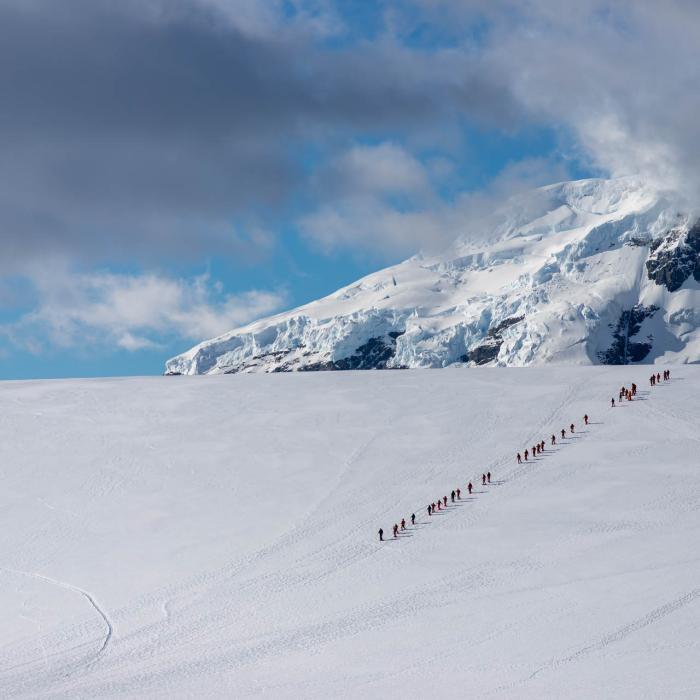
IAATO 2022-23 Biosecurity Protocols Regarding Avian Influenza
Since the beginning of 2022, the increasing intensity of highly pathogenic avian influenza (HPAI) H5N1 outbreaks has resulted in the death of hundreds of thousands of seabirds in the Northern Hemisphere, around the Atlantic and Pacific Oceans and southern Africa. HPAI has also caused elevated grey and harbour seal mortalities in the United States.
Polar stakeholders, from Antarctic Treaty parties to scientists, researchers and IAATO tour operators already have robust procedures in place to protect Antarctica from pathogens and non-native species, but due to the increase of avian influenza elsewhere in the world, we are all heightening our vigilance with regards to operations South this season.
Here’s what you need to know about the response to Avian Influenza:
Stakeholders and scientists in the Antarctic community are responding to the threat of Avian Influenza collectively.
In consultation with the SCAR Antarctic Wildlife Health Working Group (AWHWG), additional protocols for the 2022-23 season have been introduced to IAATO’s standard biosecurity procedures. These protocols are mandatory for all IAATO Operators and their staff operating in Antarctica. They are also likely to evolve as more information and guidance regarding (HPAI) H5N1 becomes available:
- Assessing visitor sites for signs of HPAI in wildlife colonies before commencing any landing.
- Remaining vigilant for signs of HPAI and be prepared to leave a site if any behavioural signs of HPAI are detected.
- Not sitting, kneeling, or lying down on the ground or snow, or leaving any equipment on the ground or snow, close to animal activity or faecal matter (e.g., within a minimum of 10m of nests or breeding adults, wildlife transit pathways, haul out sites).
- If visitors are approached by wildlife, visitors must take appropriate action to ensure the advised minimum distance of five metres is maintained where it can be safely done.
- Camping is only permitted at sites with minimal to no wildlife.
- Staff handling seabirds found landed on ships should wear appropriate PPE including face masks and gloves, and where disease is suspected, disposable overalls/aprons and safety glasses/shield.
In addition, Operators supporting researchers who are authorised or permitted to be in direct or close contact (less than 5m) with animals must ensure the researchers are aware of the latest advice for mitigating transmission of zoonotic disease including SARS-CoV-2 and avian influenza.
What is Avian Influenza?
Avian influenza is naturally found in wild birds but are typically Low Pathogenic Avian Influenza (LPAI) viruses. They cause no clinical signs of disease in wild birds. More concerning are viral subtypes (H5 and H7) which can become highly pathogenic in domestic birds (poultry) then escape into wild populations.
What is the risk to humans?
The World Organisation for Animal Health says there is a low risk of infection in humans1. To date all human infections with HPAI have been in people who work very closely for prolonged periods of time with birds such as poultry workers. Find out more.
How is it spread?
In birds, Avian Influenza viruses are shed in the faeces and respiratory secretions. They can all be spread through direct contact with secretions from infected birds, especially through faeces or through water. Because of the resistant nature of Avian Influenza viruses, including their ability to survive for long periods when temperatures are low2, they can also be carried on clothing and equipment and spread easily from location to location. You can start your pre-expedition biosecurity now using our Don’t Pack a Pest guidance.
How can I help?
On any visit to the Antarctic, you will need to comply with robust procedures to prevent the introduction and spread of pathogens and non-native species. This process begins before you leave home and will be part of your daily routine during your visit. These procedures require you to ensure all your clothing and equipment, anything that may come into contact with the Antarctic environment, is thoroughly cleaned and disinfected. Follow your IAATO operator’s instructions closely. Once in Antarctica, maintain advised minimum distances and never touch wildlife, dead or alive, or encourage interactions.
Click here to download this document.
References
1 World Organisation for Animal Health: https://www.woah.org/en/disease/avian-influenza/
2 World Organisation for Animal Health: https://www.woah.org/en/disease/avian-influenza/
3 IAATO Don’t Pack a Pest guidance: visiting-antarctica/preparing-for-your-expedition/


